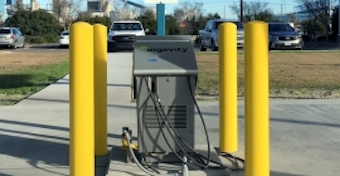How can I refuel the ANG-RNG vehicle?
A refueling appliance, Fuelmaker FMQ 2.5, is available through Ingevity. This comes with two fueling nozzles to allow fueling of two trucks at once, and has dimensions of 21 in x 20 in x 39 in.1 It is a redeployable appliance that can be installed near an existing natural gas access point. The typical refueling duration to fill an upfitted truck with an empty standard 6-GGE (gasoline gallon equivalent) ANG tank is 3.5 hours. Given this rate, ANG is ideal for fleets with private central hubs.
A comparison of charging durations for different AFV types is shown in the table below. For compressed Natural Gas (CNG), there are two types of refueling mechanism – time-fill and fast-fill. Time-fill refueling requires a direct connection to a gas line and a compressor. The refueling rate can be designed to cater to the intended use (i.e. 8-9 gallons per minute for transit buses, 3 gallons per minute for refuse trucks). Because it normally takes hours to fill CNG vehicles, time-fill set-up, like ANG refueling, works best for fleets refueling in a central location every night. Fast-fill refueling, on the other hand, fills directly from a storage tank that contains natural gas that is compressed at high pressures, usually at 4,300 psi. This set-up is ideal for retail situations where vehicles arrive randomly, as it can refuel at a rate as fast as 5 minutes per 20-gallon-equivalent tank.2 ,3
Electric vehicles have three charging equipment types. Level 1 equipment (cordset) usually comes with the EV purchase and is more suited for private refueling of individual EV owners. Level 2 equipment is offered in 240V which is typical for residential applications and in 208V for commercial applications while DC fast charging equipment is more suitable for high-traffic corridors and is what mostly installed in stations.4
|
AFV Type |
Refueling / Charge Type |
Estimated Hours of Refueling per 100-mile range |
|---|---|---|
|
ANG-RNG |
Fuelmaker FMQ 2.5 |
3.55 |
|
CNG (F-250 truck) |
Time Fill |
|
|
Fast Fill |
||
|
Plug-in Electric (PEV)8 |
Level 1 (120V) |
20 to 50 |
|
Level 2 (204V and 208V) |
10 to 20 |
|
|
DC Fast (208/480V AC 3-phase input) |
0.4 to 0.6 (24 to 36 minutes) |
Table Source: CSB author based on references cited
How much does it cost to build the refueling infrastructure?
Fuelmaker FMQ 2.5 costs $5000 and does not require large and costly infrastructure. The installation cost is estimated at $2000 and includes a regulator, a dryer, and the flowmeter that will also be used to account for RNG utilization. Note this is with the assumption that the user has an already available natural gas access point. For comparison, the US Department of Energy9 estimates the cost of building a Time Fill CNG station that can serve two sedans or pickups at a time at 5 gge per night at $10,000, while the installation of a Level 2 EV chraging station can cost up to $19,200. See table below for a summary of infrastructure installation cost for different AFV types.
|
AFV Type |
Refueling / Charge Type |
Estimated Installation Cost of Infrastructure |
Inclusions |
|
ANG-RNG |
Fuelmaker FMQ 2.5 |
$7,000 |
Includes refueling appliance purchase cost and installation cost. Can fuel up to 6 vehicles per day. |
|
CNG |
Time Fill |
$9,000 to $10,0009 |
Private fleet station serving two sedans/pickups fueling 5 gge/night outdoors |
|
Fast Fill |
$45,000 to $91,0009 |
Private fleet station serving up to four sedans/pickups fueling 10 gge/day |
|
|
Plug-in Electric (PEV) |
Level 1 (120V) |
$300* to $480010 |
*$300 is the cost of a single Level 1 electric vehicle supply equipment (EVSE) and assume zero installation cost (i.e. site host offers PEV outlet) |
|
Level 2 (204V and 208V) |
$1000 to $19,20010 |
EVSE Unit cost: $400 - $6500 Installation cost range: $600 - $12,700 |
|
|
DC Fast (208/480V AC 3-phase input) |
$14,000 to $91,00010 |
EVSE Unit cost: $10,000 - $40,000 Installation cost range: $4000 - $51,000 |
Can someone steal the fuel I’m paying for while it is pumping overnight?
The refueling appliance comes with a proprietary nozzle developed by Ingevity and CuboGas and is used to load other natural gas vehicles. The appliance automatically shuts off the refueling when the tank reaches maximum capacity and cannot be restarted to fuel other vehicles unless the appropriate control buttons are pressed in the appliance's control board. The control board can be locked and keyed when the appliance is at use and also when not, thus preventing unauthorized use. ANG refueling facilities can be installed in private properties such as fleet base or headquarters. Therefore, the possibility of the fuel being stolen is highly unlikely.

Image source: http://www.transecoenergy.com/Pages/ANG-6.2L-page.html
1 FuelMaker Corporation. (1999, January). Vehicle Refueling Appliance Installation and Service Instructions. Retrieved from https://roguevalleycleancities.org/wp-content/uploads/2016/08/39.0043-Issue-3-January-1999-FMQ-2-FMQ-2.5-FMQ-2-36-Installation-and-Service-Instructions.pdf
2 Compressed Natural Gas Fueling Stations. (n.d.). Alternative Fuels Data Center. https://afdc.energy.gov/fuels/natural_gas_cng_stations.html
9 Costs Associated With Compressed Natural Gas Vehicle Fueling Infrastructure. (n.d.). US Department of Energy. p.10. Available online at https://www.nrel.gov/docs/fy14osti/62421.pdf accessed on 01 March 2022.
